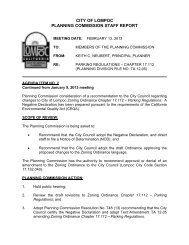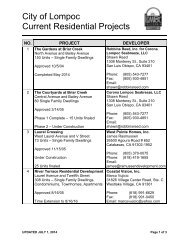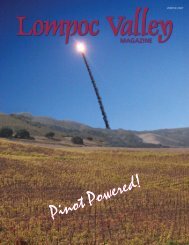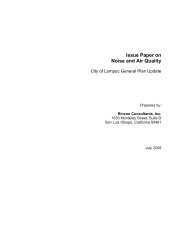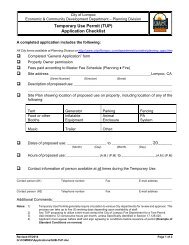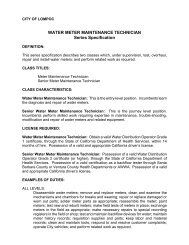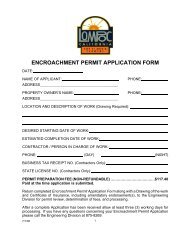Storm Water Pollution Prevention Plan (SWPPP) - the City of Lompoc!
Storm Water Pollution Prevention Plan (SWPPP) - the City of Lompoc!
Storm Water Pollution Prevention Plan (SWPPP) - the City of Lompoc!
Create successful ePaper yourself
Turn your PDF publications into a flip-book with our unique Google optimized e-Paper software.
Maintenance, Inspection and Repair ProgramThe contractor shall use <strong>the</strong> following guidelines for maintenance, inspection, and repair <strong>of</strong> BMPs identified in <strong>the</strong> <strong>SWPPP</strong> incombination with <strong>the</strong> Field Log Sheets.All BMPs must be inspected in accordance with <strong>the</strong> General Permit requirements for <strong>the</strong> associated project type andrisk level 2. In <strong>the</strong> event <strong>of</strong> a BMP failure or shortcoming, design changes to <strong>the</strong> BMP must be madeto avoid a potential violation.BEST MANAGEMENT PRACTICES INSPECTION FREQUENCYMAINTENANCE/REPAIR PROGRAM(BMPs)(all controls)NS10: Vehicle and EquipmentMaintenanceNS12: Concrete CuringInspect and verify that activitybased BMPs are in place prior to <strong>the</strong>commencement <strong>of</strong> associatedactivities. While activitiesassociated with <strong>the</strong> BMP are underway, inspect once a week during<strong>the</strong> rainy season and every twoweeks during non‐rainy season toverify continued implementation.Inspect and verify that activitybased BMPs are in place prior to <strong>the</strong>commencement <strong>of</strong> associatedactivities. While activitiesassociated with <strong>the</strong> BMP are underway, inspect weekly to verifycontinued implementation.• Inspect and ensure that all maintenanceactivities are occurring in <strong>the</strong> designatedarea.• Inspect and ensure BMPs are implementedwithin <strong>the</strong> designated area as needed.• Restock and verify that all spill containmentand cleanup materials are on‐site.• Make sure all liquids are stored in secure,labeled, leak pro<strong>of</strong> containers.• Inspect vehicles and equipment for leakseach day; repair leaks immediately orremove equipment from site.• The threshold for spills <strong>of</strong> reportablequantity varies state to state; verify <strong>the</strong>state reportable quantity <strong>of</strong> spills and <strong>the</strong>local response numbers and agencies in <strong>the</strong><strong>SWPPP</strong>.• Inspect petroleum product liquid quantity <strong>of</strong><strong>the</strong> on‐site container. If <strong>the</strong> combinedstorage capacity is greater than 1,320gallons <strong>the</strong> site is subject to 40 CFR Part 112regulations and must develop Spill<strong>Prevention</strong>, Control and Countermeasure(SPCC) <strong>Plan</strong> (www.epa.gov/oilspill/spcc.htmfor more information).• Inspect BMPs subject to non‐storm waterdischarges daily while non‐storm waterdischarges occur.• Inspect BMPs subject to non‐storm waterdischarges daily while non‐storm waterdischarges occur.• Sample non‐storm water discharges andstorm water run<strong>of</strong>f that contacts uncuredand partially cured concrete as required.• Inspect cure containers and sprayingequipment for leaks.• Ensure that employees and subcontractorsimplement appropriate measure forstorage, handling and use <strong>of</strong> curingcompounds.



